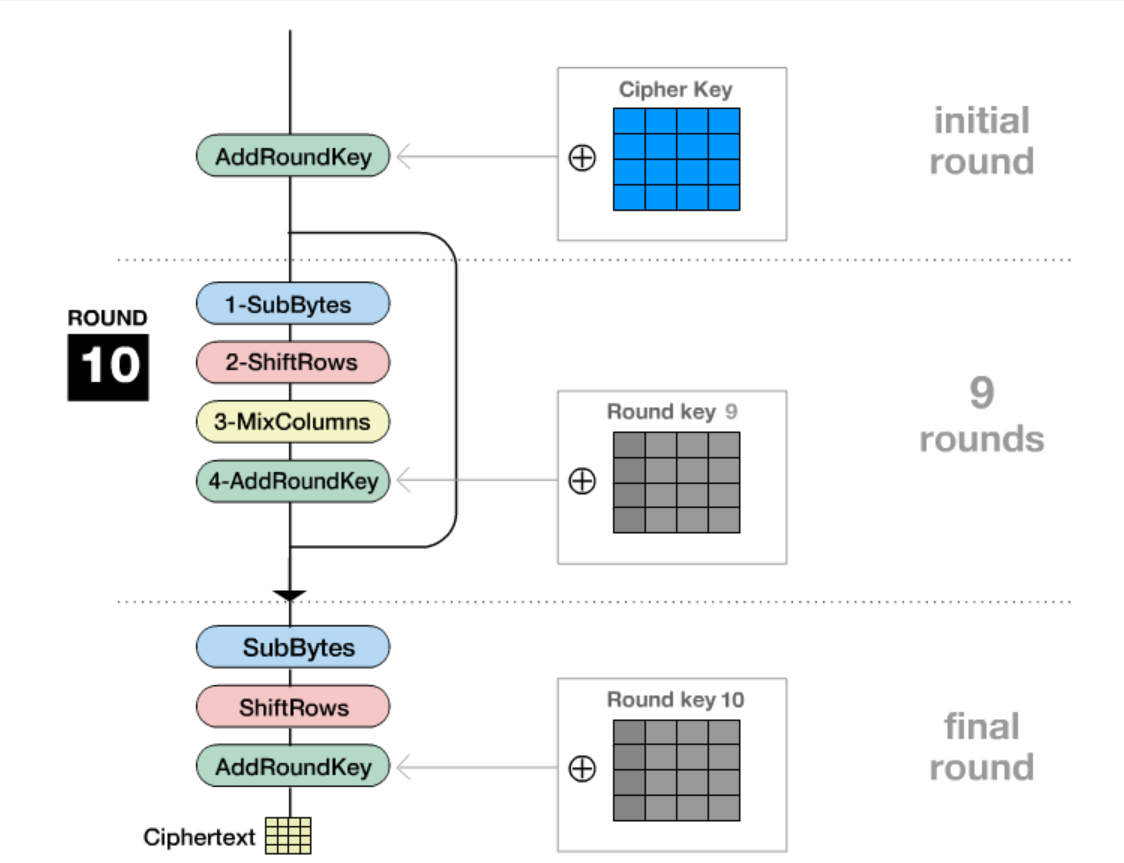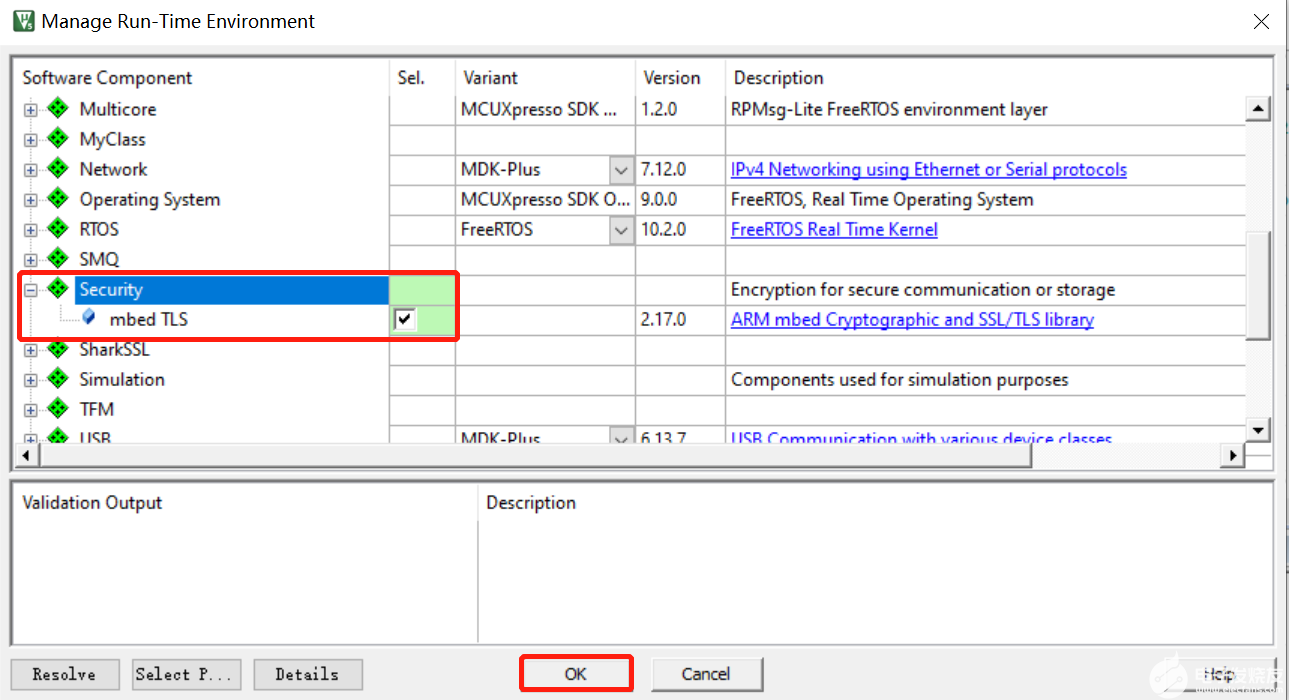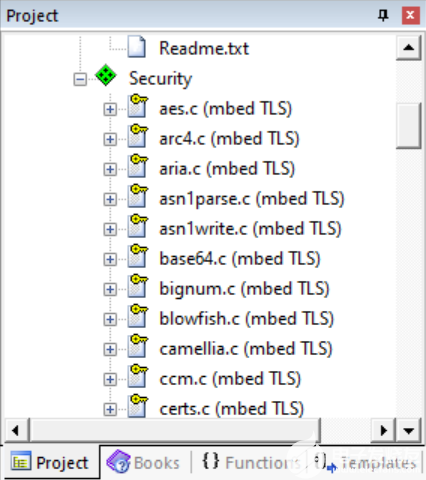

基于mbedTLS在Apollo3 MCU上实现AES-256加解密算法
描述
上海润欣科技股份有限公司创研社
最近有客户咨询,希望能够在刚完成设计的Apollo3产品上增强加密功能,主要是为了防止破解者非法克隆产品。客户同时又提到Apollo3芯片资料上有写到支持AES-128硬件加密模块,还有唯一UID号码,看看能不能把这两块利用起来,做“一机一密”的硬件保护。UID好处理,Apollo3将64位的全球唯一ID号(Unique Chip ID)存放在固定的地址上,直接读取就好了。然而,Apollo3芯片手册上仅仅介绍了Apollo3支持硬件AES-128硬件加密特性,但再也找不到更多相关的信息,官方提供的SDK里面也没有AES的任何实现代码。既然客户提出了需求,我们就要想办法实现。芯片自带的硬件AES暂时无从下手,那么我们先来看看软件AES算法如何?
首先,我们还是先来了解一下什么是AES吧
AES,全称是The Advanced Encryption Standard,翻译成中文是:高级加密标准,但我们一般还是习惯读作AES。AES是一种对称密钥算法,用于数据的加密和解密。在密码学中AES又称作Rijndael加密算法,是美国联邦政府采用的一种区块加密标准。AES是由美国国家研究院标准与技术(NIST)从2001年开始建立的一套数字加密标准,发布于FIPS PUB 197,并在2002年5月26日成为有效的标准。2006年,高级加密标准已然成为对称密钥加密中最流行的算法之一。AES取代了原先的数据加密标准(DES),已经被多方分析且广为全世界所使用。AES使用128位固定大小的数据块作为分组数据加密和解密数据,即明文分组的长度固定为128位或16字节。AES可以使用128、192 和 256 位密钥,根据密钥长度不同,AES可分为AES-128,AES-192和AES-256。
AES加解密算法是基于置换和代替的。置换是指数据的重新排列,而代替是用一个单元数据替换另一个。AES使用了如下几种不同的技术来实现置换和替换。
字节替代(SubBytes):
通过非线性的替换函数,用查找表的方式把分组的字节矩阵中的每个字节用同一个S-BOX替换成另外一个字节。
行移位(ShiftRows):
一个简单的位置交换。将矩阵中的每个横列进行循环式移位。
列混淆(MixColumns):
列混淆其实就是对一个状态的每一列去乘一个矩阵,其中乘法是在有限域GF(2^8)内进行的,不可约多项式为x^8+x^4+x^3+x+1。如下图1所示。为了充分混合矩阵中各个直行的操作。这个步骤使用线性转换来混合每列的四个字节。

图1列混淆(MixColumns)
注意,最后一个加密循环中省略MixColumns步骤,而以另一个AddRoundKey取代。
轮密钥加(AddRoundKey):
当前分组矩阵中的每一个字节和该次轮密钥(round key)进行按位异或运算。轮密钥是通过Key Schedule过程从密码密钥中得到的,轮密钥长度等于分组长度。
密钥的长度不同,加密轮数也不同,如下图2所示:

图2 不同长度密钥的AES加密轮数
如下图3所示是AES-128的加密的流程:

图3 AES-128的加密的流程示意图
对AES算法原理及实现过程感兴趣的同学,可以上网搜索更多关于AES的资料,这里不再详述算法实现流程,重点讨论怎么把AES这套算法在Apollo3 MCU上跑起来。
要实现AES算法,我了解到mbedTLS有成熟的AES加密算法库支持,那么让我们再来看看什么是mbedTLS吧。
mbedTLS,前身是PolarSSL,不管是arm掏钱买的,还是人家PolarSSL大方送的,总之,PolarSSL现在已经属于arm的资产了,而且arm官宣PolarSSL是arm的一部分了,还给改了个洋气的名字叫mbedTLS。官方网页置顶处赫然写着醒目的标题:PolarSSL is now part of arm Official announcement and rebranded as Mbed TLS。arm mbedTLS官方网站链接是:https://tls.mbed.org/。如下图4。

图4 mbedTLS官方网站
mbedTLS前世今生了解清楚了,我们还是回到正题,看看mbedTLS是什么,有哪些功能。
mbedTLS是TLS和SSL协议的实现,并且需要相应的加密算法和支持代码。mbed TLS在Apache2.0许可证或GPL2.0许可证下作为开放源码提供。Apache2.0许可证允许您在开放源码和封闭源码项目中使用mbed TLS。宽松的开源许可证,说白了,就是鼓励大家用起来,用开来(当然,最好是希望你用在arm自家的内核MCU上。^_^)。网站宣传mbed TLS的两大特点:Easy to use and Easy to get(容易使用,容易获得)。
mbedTLS核心SSL 库代码是使用完全符合ANSI-C和MISRA-C的C语言编写。mbedTLS实现了SSL模块,基本加密功能并提供各种实用功能,如大家常见的AES, DES, RSA, SHA,MD5等都已经完整实现了。与OpenSSL和其他TLS的实现不同,mbed TLS的设计目标是作为适合小型嵌入式设备来使用的,其最小的完整的TLS堆栈只需要60KB的Flash程序空间和64KB的RAM。它也是高度模块化的:每个组件,如加密函数,是可以独立于框架的其余部分使用。
介绍完AES及mbedTLS的基本概念之后,下面我们就开始动手干活了。
客户使用的IDE是KEIL MDK,假设我们已经打开了Apollo3 SDK里面自带的演示例程或者客户自己的项目工程,我们就开始一步一步详细介绍在Apollo3平台上如何实现AES加解密算法。
1、安装mbedTLS Pack
点击KEIL MDK菜单上的Pack Installer图标,如下图5截图红框所示,加载Pack Installer,界面如下图6所示。

图5 KEIL MDK界面上的Pack Installer图标

图6 Pack Installer界面
在设备厂家ARM目录下找到ARM::mbedTLS,图6显示我已经安装好了最新的v1.6.0版本;如果没有安装,点击Install安装,或者点击Update将版本升级到最新的v1.6.0版本。
2、加载mbedTLS组件到我们的工程中
点击KEIL MDK菜单上的Manage Run-Time Environment图标,如下图7截图红框所示,加载Manage Run-Time Environment,界面如下图8所示。

图7 KEIL MDK界面上Manage Run-Time
Environment图标

图8 Manage Run-Time Environment界面
在Manage Run-Time Environment的这个界面上面找到Security,勾选mbedTLS,点击OK按钮退出。
这个时候,我们在KEIL MDK项目工程目录下就能看到多了一个Security组件及其源代码列表,如下图9所示。

图9 添加Security组件到项目工程中
3、添加头文件到代码里,并修改mbedTLS_config.h文件
在需调用mbedTLS的AES API的代码里添加如下头文件:
#include "mbedtls/entropy.h"
#include "mbedtls/ctr_drbg.h"
#include "mbedtls/aes.h"
根据自己需要使用到的功能,修改mbedTLS_config.h文件,比如我这里需要用到AES,那么就需要打开相应的宏定义就好了。对于AES的ECB和CBC加解密,打开如下的这几个宏定义:
#define MBEDTLS_AES_ROM_TABLES
#define MBEDTLS_CIPHER_MODE_CBC
#define MBEDTLS_AES_C
#define MBEDTLS_CIPHER_PADDING_PKCS7
#define MBEDTLS_NO_PLATFORM_ENTROPY
#define MBEDTLS_CTR_DRBG_C
#define MBEDTLS_ENTROPY_C
#define MBEDTLS_SHA256_C
4、AES加密解密相关API介绍
根据需要我们大致经常会用到AES的两种加密模式ECB和CBC。
ECB:就是把数据块进行加密,每16字节为一块,依次进行加密,直到完成,长度不足的补0。
CBC:cipher block chaining,是一种循环模式,前一个分组的密文和当前分组的明文异或后再加密,这样做的目的也是为了增强破解难度。
AES-ECB加解密算法API:
/**
* \brief This function performs an AES single-block encryption or
* decryption operation.
*
* It performs the operation defined in the \p mode parameter
* (encrypt or decrypt), on the input data buffer defined in
* the \p input parameter.
*
*mbedtls_aes_init(), and either mbedtls_aes_setkey_enc() or
* mbedtls_aes_setkey_dec() must be called before the first
* call to this API with the same context.
*
* \param ctx The AES context to use for encryption or decryption.
* It must be initialized and bound to a key.
* \param mode The AES operation: #MBEDTLS_AES_ENCRYPT or
* #MBEDTLS_AES_DECRYPT.
* \param input The buffer holding the input data.
* It must be readable and at least \c 16 Bytes long.
* \param output The buffer where the output data will be written.
* It must be writeable and at least \c 16 Bytes long.
* \return \c 0 on success.
*/
int mbedtls_aes_crypt_ecb( mbedtls_aes_context *ctx,
int mode,
const unsigned char input[16],
unsigned char output[16] );
AES-CBC加解密算法API:
/**
* \brief This function performs an AES-CBC encryption or decryption operation
* on full blocks.
*
* It performs the operation defined in the \p mode
* parameter (encrypt/decrypt), on the input data buffer defined in
* the \p input parameter.
*
* It can be called as many times as needed, until all the input
* data is processed. mbedtls_aes_init(), and either
* mbedtls_aes_setkey_enc() or mbedtls_aes_setkey_dec() must be called
* before the first call to this API with the same context.
*
* \note This function operates on full blocks, that is, the input size
* must be a multiple of the AES block size of \c 16 Bytes.
*
* \note Upon exit, the content of the IV is updated so that you can
* call the same function again on the next
* block(s) of data and get the same result as if it was
* encrypted in one call. This allows a "streaming" usage.
* If you need to retain the contents of the IV, you should
* either save it manually or use the cipher module instead.
*
*
* \param ctx The AES context to use for encryption or decryption.
* It must be initialized and bound to a key.
* \param mode The AES operation: #MBEDTLS_AES_ENCRYPT or
* #MBEDTLS_AES_DECRYPT.
* \param length The length of the input data in Bytes. This must be a
* multiple of the block size (\c 16 Bytes).
* \param iv Initialization vector (updated after use).
* It must be a readable and writeable buffer of \c 16 Bytes.
* \param input The buffer holding the input data.
* It must be readable and of size \p length Bytes.
* \param output The buffer holding the output data.
* It must be writeable and of size \p length Bytes.
*
* \return \c 0 on success.
* \return #MBEDTLS_ERR_AES_INVALID_INPUT_LENGTH
* on failure.
*/
int mbedtls_aes_crypt_cbc( mbedtls_aes_context *ctx,
int mode,
size_t length,
unsigned char iv[16],
const unsigned char *input,
unsigned char *output );
声明一个结构体类型,成员分别存放AES的参数,如加密轮数,轮密钥指针,生成轮密钥的缓冲区等。
/**
* \brief The AES context-type definition.
*/
typedef struct mbedtls_aes_context
{
int nr; /*!< The number of rounds. */
uint32_t *rk; /*!< AES round keys. */
uint32_t buf[68]; /*!< Unaligned data buffer. This buffer can
hold 32 extra Bytes, which can be used for
one of the following purposes:
Alignment if VIA padlock is
used.
Simplifying key expansion in the 256-bit
case by generating an extra round key.
*/
}mbedtls_aes_context;
结构体初始化函数:
/**
* \brief This function initializes the specified AES context.
*
* It must be the first API called before using
* the context.
*
* \param ctx The AES context to initialize. This must not be \c NULL.
*/
void mbedtls_aes_init( mbedtls_aes_context *ctx );
AES-128 CBC加密参考代码:
mbedtls_aes_context aes_ctx;
// 初始化结构体
mbedtls_aes_init( &aes_ctx );
// 设置解密密钥
mbedtls_aes_setkey_dec(&aes_ctx, key, 128);
// AES-128 CBC加密
mbedtls_aes_crypt_cbc(&aes_ctx, MBEDTLS_AES_ENCRYPT, 64, iv, plain, cipher);
AES-128 CBC解密参考代码:
mbedtls_aes_context aes_ctx;
// 初始化结构体
mbedtls_aes_init( &aes_ctx );
// 设置解密密钥
mbedtls_aes_setkey_dec(&aes_ctx, key, 128);
// AES-128 CBC解密
mbedtls_aes_crypt_cbc(&aes_ctx, MBEDTLS_AES_DECRYPT, 64, iv, cipher, dec_plain);
至此,在Apollo3 MCU上实现AES算法的步骤已经全部完成。
看看,基于mbedTLS在Apollo3 MCU上实现MCU算法是不是特别简单、易用?那么回到客户的问题,我们如何利用芯片唯一ID结合AES加密算法来做点加密呢。
1、 读取芯片UID
通过阅读Apollo3 MCU芯片Datasheet,我们知道64位全球唯一ID号(Unique Chip ID)连续存放在固定的地址上,起始地址为:0x40020004。这个唯一ID号每片芯片都不同的。如下图10所示。

图10 Apollo3 芯片Unique Chip ID
读取UID的代码很简单:
uint32_t uid0, uid1;
uid0 = (*((uint32_t *)0x40020004));
uid1 = (*((uint32_t *)0x40020008));
2、 利用芯片UID构造AES明文序列和密钥
我们把uid0和uid1做异或得到一个常数,利用这个常数来构造AES加密的明文序列和密钥。参考代码如下:
uint32_t i;
uint32_t seed;
unsigned int temp;
unsigned char _aKey[32];
unsigned char _aPlaintext[256];
unsigned char _aCipher[256]={0};
unsigned char _aIV[16] = {0};
seed = uid0 ^ uid1;
// _aPlaintext[256]
i = 0;
do
{
_aPlaintext[i] = (unsigned char)((seed + i)^0x5A5A5A5A5A);
++i;
}while ( i < 256 );
// _aKey[32]
i = 0;
do
{
temp = seed >> i;
*(_aKey+i) = (unsigned char)(temp ^ 0xA5A5A5A5A5);
i++;
}while ( i < 32 );
3、 AES加密生成产品特征码
最后,对上述生成的明文序列_aPlaintext[256]和密钥_aKey[32]执行AES-256 CBC加密算法,并将密文结果_aCipher[256]做CRC32运算,参考代码如下:
mbedtls_aes_init( &aes_ctx );
mbedtls_aes_setkey_enc(&aes_ctx, _aKey, 256);
mbedtls_aes_crypt_cbc(&aes_ctx, MBEDTLS_AES_ENCRYPT, 256, _aIV, _aPlaintext, _aCipher);
return CalcCRC32(_aCipher, 256, 0);
最终得到4字节的结果我们将其看作是产品的唯一特征码,真正做到一机一密,可以用它来验证原装产品,也可以防止非法破解和克隆产品。我们可以将这个特征码存放到用户指定的Flash区域或者INFO里面,上电后根据上述流程做AES加密算法后,结果与存储在芯片的特征码做比对,只有原装产品才允许运行代码,有效杜绝产品被非法克隆的风险。
在其他IDE环境下加载并使用mbedTLS组件
如果说你偏好的IDE不是Keil MDK,那么也没有关系,毕竟mbedTLS的源代码还是非常容易获取的,你可以从arm/TLS官网:https://tls.mbed.org/直接下载,点击下面的图标也可以直接下载哦。
另外,还有一种方法。
arm官方Github账号上Git完整源代码:git clone https://github.com/ARMmbed/mbedtls.git,当然,以后你也可以不定期地git pull,申请到最新的版本更新,下载和更新都非常的方便。将mbedTLS源码(library文件夹下)全部添加到你的工程里面,并在你要调用mbedTLS API的代码里面添加相应的头文件,配置一下mbedTLS_config.h头文件里面的宏定义就可以正常使用了。mbedTLS API的调用方法和Keil MDK里面完全一样,毕竟mbedTLS是用纯C语言编写的,不存在移植的问题。
后记
也许大家还想知道添加mbedTLS AES加密算法到项目里面会占用多少Flash和SRAM空间。我们拿数据说话吧,经过对比加入AES前后产生的map文件得知,项目中加入AES-256 CBC加解密算法代码的部分占用Flash 11.63KB, SRAM 0KB(armcc编译器优化 Level0(-O0)),对MCU的存储资源占用较少,对整个系统的影响很小。
再来看看AES-256 CBC的实际运行效率,我们利用ARM内核自带的Systick Timer,对AES加密操作进行计时,看看到底消耗多少时间。参考代码如下:
unsigned int old_primask = __get_PRIMASK();
__disable_irq();
SysTick->CTRL = 0; // Disable SysTick
SysTick->LOAD = 0xFFFFFF; // Count down from maximum value
SysTick->VAL = 0; // Clear current value to 0
SysTick->CTRL = 0x5; // Enable SysTick, and use processor clock
while (SysTick->VAL == 0); // Wait until SysTick reloaded
START_TIME = SysTick->VAL; // Read start time value
mbedtls_aes256_cbc_test();
STOP_TIME = SysTick->VAL; // Read stop time value
SysTick->CTRL = 0; // Disable SysTick
if ((SysTick->CTRL & 0x10000) == 0) // if no overflow
DURATION = START_TIME - STOP_TIME; // Calculate total cycles
else
printf ("Timer overflowed\n");
// SysTick->VAL递减,减到0就产生了溢出,需要RELOAD
// DURATION越小说明程序执行时间越短,效率越高!
printf("DURATION of process of mbedtls_aes_cbc_test() : 0x%.8X.\n\r", DURATION);
__set_PRIMASK(old_primask);
从实验数据得知,运行一次明文长度为256字节的AES-256 CBC加密算法耗时仅需1.2ms(Apollo3 running @ 48MHz),这对于系统来说影响也很小。
- 相关推荐
- 热点推荐
- mbedTLS
-
AES加解密算法逻辑实现及其在蜂鸟E203SoC上的应用介绍2025-10-29 90
-
硬件加解密主要优点及引擎种类2023-08-28 733
-
怎么解决Ambiq Apollo3移植链接脚本出错的问题呢?2023-03-14 999
-
mbedtls开源库在单片机的数据加解密中有何作用2022-01-20 1605
-
如何对AES加解密效率进行测试呢2021-11-11 1638
-
硬件加解密的分类2021-07-22 1194
-
如何利用FPGA的硬件描述语言来实现AES的加解密算法?2021-04-08 2145
-
可编程AES加解密IP2021-01-21 2375
-
哪里可以找到AES-192和AES-256的Verilog代码?2019-09-11 2578
-
基于FPGA的可编程AES加解密IP2018-11-15 3279
-
一种AES密码算法的实现2017-11-23 3668
-
基于stm32f030单片机的AES128bit加解密算法例程2015-11-28 27478
-
labviewAES加解密小程序2012-02-22 17516
-
高级加密标准及加解密算法实现研究2008-10-24 657
全部0条评论

快来发表一下你的评论吧 !

